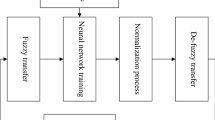Abstract
Calculation of the reaction force is critical for the design of planetary sampling devices, and this paper discusses a new method based on the predicted zone of influence. According to accurate DEM simulations, the influence zone was defined from the calculation of the threshold particle displacement. To predict the influence zone, a back-propagation artificial neural network was trained with multiple simulated data. The reaction force can be calculated by computing the force along the external edge of the predicted influence zone. With consideration of the influence zone but without DEM simulation, this new method is accurate and effective.



















Similar content being viewed by others
References
Wilkinson A, DeGennaro A (2007) Digging and pushing lunar regolith: classical soil mechanics and the forces needed for excavation and traction. J Terrramech 44(2):133–152
Liang L, Zhao Z, Zhao Y (2014) Prediction of lunar regolith excavation resistance and optimization of excavation parameters for minitype sampler. J Astronaut 35(1):39–46 (in Chinese)
Zhang T, Goldman DI (2014) The effectiveness of resistive force theory in granular locomotion. Phys Fluids 26(101308):1–16
Askari H, Kamrin K (2016) Intrusion rheology in grains and other flowable materials. Nat Mater 15:1274–1279
Craft J, Wilson J, Chu P, Zacny K, Davis K (2010) Percussive digging systems for planetary research. IEEE Aerosp Electron Syst Mag 25(10):21–26
Iai M, Gertsch L (2013) Excavation of lunar regolith with large grains by rippers for improved excavation efficiency. J Aerosp Eng 26(1):97–104
Green A, Zacny K, Pestana J, Lieu D, Mueller R (2013) Investigating the effects of percussion on excavation forces. J Aerosp Eng 26(1):87–96
Diaz Lankenau GF, Skonieczny K, Whittaker WL, Wettergreen DS (2012) Effect of bucket-wheel scale on excavation forces and soil motion. J Terrramech 49(6):341–348
Skonieczny K, Wettergreen DL, Whittaker WL (2016) Advantages of continuous excavation in lightweight planetary robotic operations. Intern J Robot Res 35(9):1121–1139
King RH, Van Susante P, Gefreh MA (2011) Analytical models and laboratory measurements of the soil–tool interaction force to push a narrow tool through JSC-1A lunar simulant and Ottawa sand at different cutting depths. J Terrramech 48(1):85–95
Agui JH, Bucek M, DeGennaro A, Wilkinson RA, Zeng X (2013) Lunar excavation experiments in simulant soil test beds: revisiting the surveyor geotechnical data. J Aerosp Eng 26(1):117–133
Zhao Z (2014) Lunar surface sampling study on mechanical characteristics of tool-soil interaction. Ph.D. thesis, Jilin University (in Chinese)
Boles WW, Scott WD, Connolly JF (1997) Excavation forces in reduced gravity environment. J Aerosp Eng 10(2):99–103
Green A, Zacny K (2014) Effect of Mars atmospheric pressure on percussive excavation forces. J Terrramech 51:43–52
Xue L, Chen B, Zhao Z, Dang Z, Zou M (2016) Experimental study of torque using a small scoop on the lunar surface. Intern J Aerosp Eng 2016:1–8
Hasan A, Alshibli KA (2010) Discrete element modeling of strength properties of Johnson Space Center (JSC-1A) lunar regolith simulant. J Aerosp Eng 23(3):157–165
Jiang M, Shen Z, Utili S (2016) DEM modeling of cantilever retaining excavations implications for lunar constructions. Eng Comput 33(2):366–394
Jiang M, Zheng M, Wang C (2012) Distinct element analysis of shear band of lunar soil in biaxial tests. Rock Soil Mech 12:3801–3809 (in Chinese)
Xi B, Jiang M, Dai Y, Shen Z (2014) DEM analyses of horizontal excavation in lunar soil. In: Conference of computational mechanics of granular materials (CMGM-2014), Lanzhou (in Chinese)
Jiang M, Xi B, Shen Z, Dai Y (2015) DEM analyses of horizontal pushing resistance under different gravity fields. Chin J Geotech Eng 07:1300–1306 (in Chinese)
Jiang M, Xi B, Shen Z, Dai Y (2016) Discrete element numerical analysis of factors affecting horizontal pushing resistance in lunar ground excavation. Rock Soil Mech 37(1):229–236 (in Chinese)
Jiang M, Xi B, Shen Z, Dai Y (2016) DEM analyses of horizontal pushing test on lunar ground. Chin J Undergr Sp Eng 03:712–718 (in Chinese)
Li Q (2014) Research and application on surface sampling theoretical model based on lunar soil simulant. Ph.D. thesis, China University of Geosciences (in Chinese)
Zheng Y, Ouyang Z, Wang S, Zou Y (2004) Physical and mechanical properties of lunar regolith. J Miner Pet 04:14–19 (in Chinese)
Kovanko BB, Luszuk HГ, Komis Sarczuk AA (2013) Lunar soil characteristics and development technology. National Defense Industry Press, Beijing (in Chinese)
Matsushima T, Katagiri J, Uesugi K, Tsuchiyama A, Nakano T (2009) 3D shape characterization and image-based DEM simulation of the lunar soil simulant FJS-1. J Aerosp Eng 22(1):15–23
Katagiri J, Matsushima T, Yamada Y, Tsuchiyama A, Nakano T, Uesugi K, Ohtake M, Saiki K (2015) Investigation of 3D grain shape characteristics of lunar soil retrieved in Apollo 16 using image-based discrete-element modeling. J Aerosp Eng 28:040140924
Chen Z, Zhou J, Wang H (2004) Soil Mechanics. Tsinghua University Press, Beijing (in Chinese)
Acknowledgements
The authors gratefully acknowledge Professor Takashi Matsushima of the University of Tsukuba for DEM software, equipment and theoretical guidance during the research. This project was financially supported by the National Natural Science Foundation of China (No. 11502034) and China Scholarship Council (No. 201608510014). Theoretical support from Chengdu University of Technology and the State Key Laboratory of Geohazard Prevention and Geoenvironment is also acknowledged.
Author information
Authors and Affiliations
Corresponding author
Additional information
Publisher's Note
Springer Nature remains neutral with regard to jurisdictional claims in published maps and institutional affiliations.
Rights and permissions
About this article
Cite this article
Qian, L., Matsushima, T., Lanlan, X. et al. Reaction force calculation for planetary sampling devices based on the predicted zone of influence. Comp. Part. Mech. 8, 1–20 (2021). https://doi.org/10.1007/s40571-019-00308-2
Received:
Revised:
Accepted:
Published:
Issue Date:
DOI: https://doi.org/10.1007/s40571-019-00308-2




